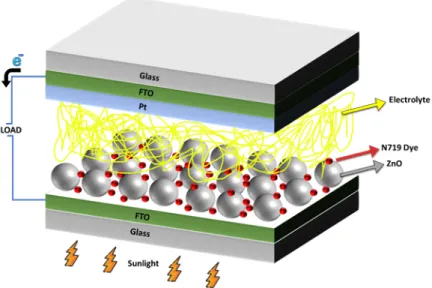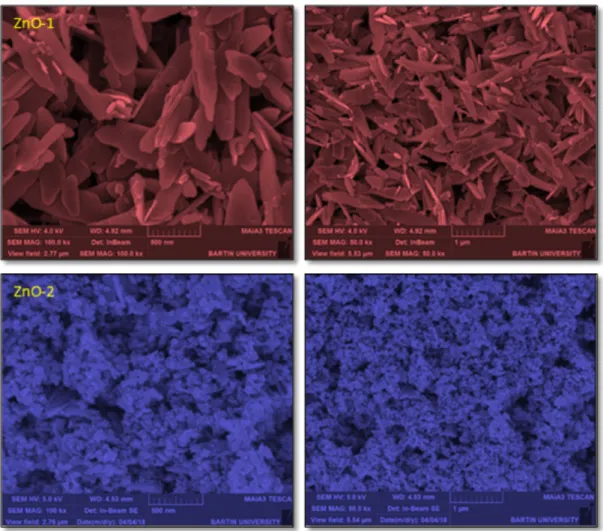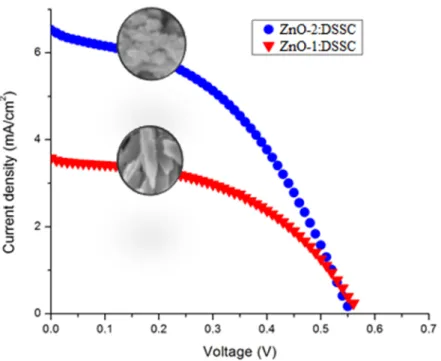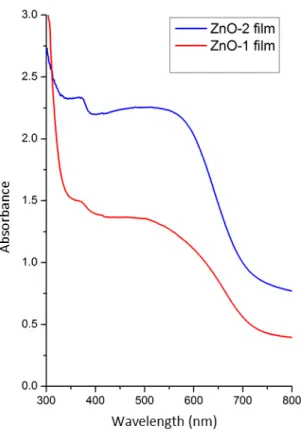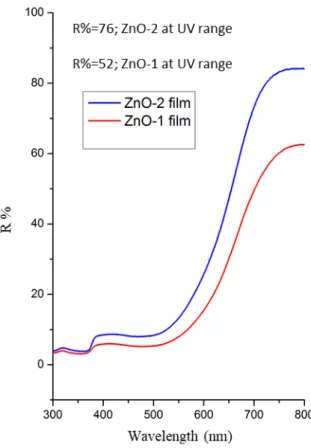The Effect of Morphology of Photoanode on Photovoltaic Properties of ZnO-DSSC
Halil EŞGİN1,*, Yasemin ÇAĞLAR21Cukurova University, Central Research Laboratory, Adana, Turkey esginhalil@gmail.com, ORCID: 0000-0001-6659-5519
2Eskisehir Technical University, Faculty of Science, Department of Physics, Yunusemre Campus, Eskisehir, Turkey
yasemincaglar@eskisehir.edu.tr, ORCID: 0000-0001-8462-0925
Received: 22.03.2020 Accepted: 30.05.2020 Published: 25.06.2020
Abstract
In this work, ZnO nanopowders with different morphology such as nanoleafy and nanosphere were synthesized by hydrothermal method. The X-ray Diffraction (XRD) spectra have showed that ZnO nanopowders synthesized in different morphologies have a highly crystallized hexagonal structure. Scanning Electron Microscopy (SEM) was used to examine the morphology of nanopowders and revealed that they were formed in the nanoleafy and nanosphere structure. Dye-Sensitized Solar Cell (DSSC) fabrication was performed by using ZnO nanopowders as a photoelectrode. The Dye-Sensitized Solar Cells (DSSCs) were immersed in N719 dye at 4h and the performance of the cells (conversion efficiency, open circuit voltage, fill factor and short circuit current) of ZnO-DSSCs were obtained. It has been observed the highest efficiency value of 1.59% for nanosphere ZnO:DSSC.
Keywords: ZnO nanopowders; Hydrothermal method; DSSC.
ZnO-DSSC’lerin Fotovoltaik Özelliklerine Fotoanodun Morfolojisinin Etkisi Öz
Bu çalışmada, nano küre ve yaprak benzeri gibi farklı morfolojiye sahip ZnO nanotozları hidrotermal yöntemle sentezlenmiştir. Farklı morfolojilerde sentezlenen ZnO nanotozlarının, hegzagonal yapıda kristallendikleri XRD spektrumlarından belirlenmiştir. Nanotozların morfolojisini incelemek için Taramalı Elektron Mikroskobu (SEM) kullanılmış ve yapılarda nano boyutta yaprağımsı ve küresel fomlar gözlenmiştir. DSSC fabrikasyonu, farklı morfolojilerde ZnO tozları kullanılarak yapılmıştır. DSSC’ler 4 saat N719 boyasına daldırılmış ve ZnO-DSSC’lerin hücrelerinin pil performansları (kısa devre akımı, açık devre voltajı, verimi ve dolum faktörü) belirlenmiştir. En yüksek verim değeri, küre benzeri nano yapıya sahip ZnO: DSSC için %1.59 olarak bulunmuştur.
Anahtar Kelimeler: ZnO nanotozları; Hidrotermal metot; DSSC.
1. Introduction
Until now, due to the increasing energy demand and fossil fuel consumption, finding approaches to convert light from solar to electrical energy has become the focus of the world energy field. The most common and reliable energy source is the light from the sun. However, the cost and efficiency of solar power generation are one of the biggest barriers to transition to environmentally friendly and sustainable technology. DSSCs, which are the third-generation photovoltaic devices, has attracted great attention in the last two decades due to its good aspects such as low production cost, simple production process and higher energy conversion efficiency. DSSCs have many advantages compared to other photovoltaic devices due to their superior performance even under low intensity light, low reflection angle and high temperature conditions.
Various factors play important roles in the selection of semiconductors in DSSCs. First of all, the selected semiconductor should facilitate charge separation, effective electronic coupling and minimize recombination. Hence, the semiconductor must have band energy and density of state compatible with the energy levels of the dye. Secondly, the semiconductor morphology should offer a high surface area to provide high light absorption through the dye layer, while at the same time it should provide good electrical conduction to the substrate [1].
In DSSCs, charge separation takes place by electron transfer from the dye excited under light to the conduction band of the photoanode. Generally, titanium oxide (TiO2) has been used as a photoanode in DSSCs. But zinc oxide (ZnO), which has better electrical properties than TiO2, is considered to be the best alternative to be used in DSSCs [2].
The circuit elements to be prepared with nanostructured semiconducting materials may exhibit a different characteristic from the electronic circuit elements prepared with typical
semiconductors, resulting in the change of the electronic circuit performances of these materials. In order to increase the efficiency of DSSCs, some studies have been performed for the preparation of ZnO films, which are promising as photo-anodes in different morphologies [1-3]. In the literature, the techniques such as hydrothermal [4], thermal decomposition [5], microwave assisted hydrothermal [6], sol-gel method [7] are used to obtain ZnO nanopowder. The hydrothermal method is a method based on high-pressure crystallization from high temperature aqueous solutions. Due to the advantages such as low cost, low temperature, potential controllability in terms of shape and size, the unexpected hydrothermal method allows the formation of nano-morphologies that cannot be obtained by conventional reactions and their associated traditional methods [8].
Nanostructured ZnO can be produced in different morphologies such as sphere, nanowire, nanosheets, and nanoflower with this method. Morphology has a significant effect on DSSC efficiency. In recent years, ZnO nanostructure has been produced in different morphologies by hydrothermal method and DSSCs have been created using these powders. Zhu et al. [9] produced ZnO crystals with different morphologies, such as micro rods, hierarchical microspheres and hollow microspheres by hydrothermal method. They found the efficiency (1.42%) of DSSC made with ZnO in hierarchical microspheres structure higher than that of DSSC in other morphology. They attributed the reason for this high efficiency to better hierarchical microspheres to absorb higher dye molecules and better light scattering. Wang and his colleagues [10] synthesized nanorod and nanoflower like ZnO nanocrystals by hydrothermal method using hexadecyl trimethyl ammonium bromide (CTAB). They observed that the efficiency (1.37%) of DSSC produced with nanoflower ZnO was higher than that of DSSC using nanorod. The authors said that the capacity of the flower structure to absorb the dye increases efficiency because it is more than the rod structure. Three-dimensional (3D) ZnO hierarchical microspheres consisting of nanorods were synthesized by Li et al. [11] by hydrothermal method without any surfactant. The authors changed the morphology of ZnO powders by changing reaction conditions such as reaction temperature and reaction time. They found the efficiency of the DSSC produced with the nanosheet ZnO to be 3.75%. They emphasized that nanorod ZnO hierarchical structures show excellent photoelectric properties due to the high surface area and relatively fast electronic transmission path.
One of the parameters played an important role on the electrical performance of DSSCs is the structural morphology of the photoanode. Therefore, in this study, ZnO nanostructures were obtained at two different morphologies by hydrothermal synthesis method and the effects of these structures on the cell parameters have been investigated in detail.
2. Experimental Details
2.1. Deposition of ZnO nanopowders
The ZnO nanopowders were synthesized by the hydrothermal method. Zinc nitrate hexahydrate (Zn(NO3)2.6H2O, Sigma-Aldrich) and sodium hydroxide (NaOH, Sigma-Aldrich) were used as initial materials for the ZnO nanopowders. Sodium dodecyl sulfate (NaC12H25SO4, Sigma-Aldrich, SDS) and N-(1-Naphthyl) ethylenediamine dihydrochloride, (Sigma Aldrich, NND) were used as surfactant. SDS was used in the sample named as ZnO-1 and NND was used in the sample named as ZnO-2. To obtain a starting solution, Zn(NO3)2.6H2O and surfactant were dissolved in water by mixing the appropriate stoichiometric ratios of initial materials in 10 minutes and stirred for 30 minutes. After adding NaOH to starting solution by dropwise, the resulting solution was placed to 100 mL capacity of Teflon coated stainless steel autoclave. The teflon-lined stainless-steel autoclave was heated at 140 °C for 12 h. Subsequently, the autoclave was then left to cool at room temperature. The final white precipitates were collected by centrifugation and washed with deionized water and ethanol respectively. The ZnO powder were dried in an oven at 60 °C.
2.2. DSSC fabrication
Firstly, Fluorine-doped tin oxide (FTO) substrates were cleaned for 15 minutes in an ultrasonic bath and were dried in nitrogen ambient. The paste of ZnO-1 and ZnO-2 nanopowders were made using ethanol, Triton-X 100 and acetyl acetone. The obtained pastes were spread onto the FTO glass using the doctor blade method. In this method, plastic tapes were used to squeeze the paste onto the FTO substrate. The ZnO-1 and ZnO-2 films were annealed for 4 h at 450°C in air and then cooled. And then, the ZnO films were immersed into a 0.5 mM N719 for 4 hours. Finally, the dye loaded films were combined with Pt counter electrodes to give shape to DSSCs, such as sandwich-type, using a sealing tape. The cell active area is 0.36 cm2. The schematic structure and arrangement of each component of the obtained DSSC is shown in Fig. 1.
Figure 1: The components of a DSSC
The structure consists of conductive glass substrates (FTO), a dye-sensitive metal oxide semiconductor electrode (ZnO), a dye material (N719), a catalyst counter electrode (Pt) and an electrolyte solution (Iodolyte) placed between the two electrodes.
2.3. Characterization of ZnO and DSSCs
X-ray diffraction (XRD, Rigaku SMARTLAB) was used to analyse the phase of ZnO nanopowders. The morphology of ZnO nanopowders have been performed with TESCAN MAIA3 Scanning Electron Microscopy (SEM). The reflectance and absorbance measurements were performed with SHIMADZU UV-2450 spectrophotometer. The photovoltaic measurements of the DSSCs were recorded employing a solar cell measurement system (FYTRONIX OPTOSENSE).
3. Results and Discussion
Fig. 2 shows the XRD pattern of produced ZnO-1 and ZnO-2. All of the diffraction peaks are in good agreement with hexagonal structure and in polycrystalline form (ICCD card no 01-079-02006). No other characteristic peaks of the surfactant, reactant or Zn(OH)2 are found. It has been found that the production method is suitable to obtain fairly pure products. The intensities of the diffraction peaks of ZnO-1 appear to be higher compared to ZnO-2 obtained using NND. This can be explained by the higher crystallinity and particle size of the ZnO-1 nanopowder, taking into account the structural parameters shown in the Table 1.
Figure 2: The X-ray diffraction pattern of the ZnO-1 and ZnO-2 nanopowders
Using different surfactants in the starting solution led to a change in crystallinity and particle size. According to the Debye-Scherrer formula, the average crystallite sizes of ZnO-1 and ZnO-2 are calculated through the (101) planes as 65.48 nm, 38.60 nm respectively.
Table 1: Structural parameters of the ZnO nanopowders (hkl) 2q (degree) d (Å) (nm) D (hkl) (degree2q ) d (Å) (nm) D ZnO-1 (100) 31.756 2.8155 ZnO-2 (100) 31.743 2.8167 (002) 34.428 2.60286 (002) 34.404 2.6046 (101) 36.231 2.47738 65.48 (101) 36.240 2.4768 38.60 (102) 47.529 1.91151 (102) 47.536 1.9112 (110) 56.582 1.62527 (110) 56.608 1.6246 (103) 62.846 1.47750 (103) 62.736 1.4798 (200) 66.386 1.4070 (200) 66.27 1.4092 (112) 67.931 1.37874 (112) 67.952 1.3784 (201) 69.059 1.35895 (201) 69.05 1.3590 (004) 72.551 1.30191 (004) 72.46 1.3033 (202) 76.908 1.23864 (202) 76.92 1.2385
The effect of using different surfactants on morphology of ZnO nanopowders was determined by examining SEM images. The SEM images of the ZnO nanopowders are given in Fig. 3.
Figure 3: SEM images of the ZnO-1 and ZnO-2 nanopowders (left side ´100k, right side ´50k)
As seen from these images, ZnO-1 nanopowder prepared with SDS surfactant in starting solution has a sheet-like shape (nanoleafy) structure. ZnO-2 nanopowder is composed of nanospheres. The structure of ZnO-1 nanopowder consists of approximately 500´200´30 nm nanoleafy ZnO nanostructures, while ZnO-2 nanopowder consists of approximately 40 nm nanospheres. Both samples were found to have a homogeneous distribution.
The energy band diagram of DSSC, which shows the HOMO / LUMO levels of the N719 dye, the working function of the FTO, the reduction potential of the electrolyte and the conduction band (CB) and valance band (VB) band levels of ZnO, is schematically shown in Fig. 4. Accordingly, ZnO’s CB and VB energy levels are lower than the N719 paint’s LUMO and HOMO energy levels. Therefore, the photogenerated electrons in the dye can be collected from ZnO and quickly transferred to the FTO.
Figure 4: Schematic energy band diagram for FTO, ZnO and N719 dye
The energy conversion efficiency (n%) of the DSSCs varies depending on the short circuit photo current density (Jsc), open circuit photovoltage (Voc), the filling factor of the cell (FF) and
the intensity of the incident light (Pin) [12]. Based on the solar cell parameters of DSSCs, cell
efficiency (η) and fill factor (FF) can be defined as follows:
𝜂(%) =𝐹𝐹𝑥𝑉!"𝑥𝐼#"
𝑃$% 𝑥100 (1)
𝐹𝐹(%) =𝑉&'(𝑥𝐼&'(
𝑉!"𝑥𝐼#" 𝑥100 (2)
where Vmax and Imax are the voltage and current at maximum power output, respectively [13]. The
interaction of photo anodes, dye molecules, FTO substrates, counter electrodes and electrolytes with each other is highly effective on the solar cell parameters mentioned above. The basis of the operation of the DSSCs is that the dye molecules attached to the photo anode absorbs the photons from sunlight and turn themselves into the excited state. The electric field caused by the difference between the energy levels of photo anode and dye molecules drags the excited electrons into the conduction band of the ZnO photoanode. Then the electron moves to the counter electrode (CE) to complete the circuit [14].
Figure 5: J-V graph of ZnO-DSSCs
Table 2: The photovoltaic parameters of ZnO-DSSCs
The current density vs voltage graph of the DSSCs is given in Fig. 5 and corresponding parameters such as Jsc, Voc, FF and n% values are summarized in Table 2. The Voc values of both
DSSCs are around 0.55 V. Because the difference between the potential of the redox couple in the electrolyte and the quasi Fermi level energies of ZnO, this value did not change [9]. However, the DSSC parameters made with nanosphere ZnO are higher than the parameters of the cell made with nanosheet ZnO. As known, the greater the amount of dye loading in a DSSC, the greater the photo-current density. At the same time, a greater amount of dye loading ensures that the incident lights are completely absorbed, resulting in a greater short circuit current density. To determine this, the absorbance wavelength measurements of the films immersed for 4 hours in N719 dye were taken and given in Fig. 6. As seen from this figure, the ZnO-2 film has a higher absorbance value than the other film in the visible region. Also, the observed peak at about 385 nm belongs to absorption edge of ZnO.
DSSC Jsc (mA/cm2) Voc (V) n (%) FF (%)
ZnO-1:DSSC 3.58 0.56 1.02 51
Figure 6: Absorbance graphs of ZnO-1 film and ZnO-2 film
Consequently, the more dye loading is done, the more photogenic electrons and higher photo current. Also, considering that the ZnO-2 film is in nanosphere morphology, its surface area is higher than that of the nanoleafy film. This increase in surface area increased dye loading and consequently increased cell efficiency to 1.59%.
Another way to improve photocurrent is to create higher scattering ability of the photoanode. To investigate the light scattering properties of ZnO films, reflectance spectra were also measured and shown in Fig. 7. The R% value of nanosheet film (ZnO-2 film) was 76% at 400-800 nm, which was higher than the other film. The high reflectance value increased the photocurrent value of ZnO-2:DSSC compared to other DSSC. Therefore, the fact that nanosphere structured ZnO films have higher dye loading and light scattering ability compared to nanoleafy films contributed to high efficiency, resulting in increased photocurrent density and overall power conversion efficiency.
Figure 7: Reflectance graphs of ZnO-1 film and ZnO-2 film 4. Conclusion
In the study, the effect of ZnO photoanodes morphologies on solar cell parameters was investigated. For this purpose, ZnO nanospheres and nanoleafy powders with different morphologies were synthesized by hydrothermal synthesis method and used as photoanode in DSSCs. It has been determined that the synthesized nanopowders have high homogeneity and good crystallinity by structural and morphological analysis. It has been seen from the absorbance curves that ZnO-2 film has higher dye absorption capacity. Thus, ZnO-2 nanospheres absorbed more dye and showed higher device performance with much smaller grain size. In addition, ZnO-2 film with higher reflectance values, more light scattering, contributed positively to the efficiency. DSSC photoelectrodes were successfully fabricated using N719 dye sensitized ZnO nanopowders. DSSC fabricated with prepared ZnO nanosphere attains a reasonable overall conversion efficiency of 1.59%, with good JSC of 6.53 mA/cm2, VOC of 0.55 V and FF of 0.44
under sunlight intensity of 100 mW/cm2.
Acknowledgement
This work was supported by Eskisehir Technical University Commission of Scientific Research Projects under Grant No. 1706F385 and 19ADP157.
References
[1] Baxter, J.B., Aydil, E.S., Dye-sensitized solar cells based on semiconductor morphologies with ZnO nanowires, Solar Energy Materials and Solar Cells, 90(5), 607–622, 2006.
[2] Chandiran, A.K., Abdi-Jalebi, M., Nazeeruddin, M.K., Grätzel, M., Analysis of Electron Transfer Properties of ZnO and TiO2 Photoanodes for Dye-Sensitized Solar Cells, ACS Nano,
8(3), 2261–2268, 2014.
[3] Xu, F., Sun, L., Solution-derived ZnO nanostructures for photoanodes of dye-sensitized solar cells, Energy & Environmental Science, 4(3), 818–841, 2011.
[4] Qiu, Y., Chen, W., Yang, S., Facile hydrothermal preparation of hierarchically assembled, porous single-crystalline ZnO nanoplates and their application in dye-sensitized solar cells, Journal of Materials Chemistry, 20(5), 1001–1006, 2010.
[5] Alp, E., Araz, E.C., Buluç, A.F., Güner, Y., Değer, Y., Eşgin, H., Dermenci, K.B., Kazmanlı, M.K., Turan, S., Genç, A., Mesoporous nanocrystalline ZnO microspheres by ethylene glycol mediated thermal decomposition, Advanced Powder Technology, 29(12), 2018.
[6] Krishnapriya, R., Praneetha, S., Murugan, A.V., Investigation of the effect of reaction parameters on the microwave-assisted hydrothermal synthesis of hierarchical jasmine-flower-like ZnO nanostructures for dye-sensitized solar cells, New Journal of Chemistry, 40(6), 5080– 5089, 2016.
[7] Rani, S., Suri, P., Shishodia, P.K., Mehra, R.M., Synthesis of nanocrystalline ZnO powder via sol–gel route for dye-sensitized solar cells, Solar Energy Materials and Solar Cells, 92(12), 1639–1645, 2008.
[8] Xu, H., Wang, H., Zhang, Y., He, W., Zhu, M., Wang, B., Yan, H., Hydrothermal synthesis of zinc oxide powders with controllable morphology, Ceramics International, 30(1), 93– 97, 2004.
[9] Zhu, S., Tian, X., Chen, J., Shan, L., Xu, X., Zhou, Z., A Facile Approach to Construct Multiple Structured ZnO Crystals by Trisodium Citrate-Assisted Hydrothermal Growth Toward Performance Enhancement of Dye-Sensitized Solar Cells, Journal of Physical Chemistry C, 118(30), 16401–16407, 2013.
[10] Wang, C., Zhang, X., Wang, D., Yang, Z., Ji, W., Zhang, C., Zhao, Y., Synthesis of nanostructural ZnO using hydrothermal method for dye-sensitized solar cells, Science China Technological Sciences, 53(4), 1146–1149, 2010.
[11] Li, D., Li, Y., Zhang, Y., Chang, F., Facile synthesis of three-dimensional ZnO hierarchical microspheres composed of well-ordered nanorods by hydrothermal method, Results in Physics, 12, 953–958, 2019.
[12] Hongsith, K., Hongsith, N., Wongratanaphisan, D., Gardchareon, A., Phadungdhitidhada, S., Singjai, P., Choopun, S., Sparking deposited ZnO nanoparticles as double-layered photoelectrode in ZnO dye-sensitized solar cell, Thin Solid Films, 539, 260–266, 2013.
[13] Khan, M.Z.H., Al-Mamun, M.R., Halder, P.K., Aziz, M.A., Performance improvement of modified dye-sensitized solar cells, Renewable and Sustainable Energy Reviews, 71, 602–617, 2017.
[14] Rathnasamy, R., Thangasamy, P., Thangamuthu, R., Sampath, S., Alagan, V., Green synthesis of ZnO nanoparticles using Carica papaya leaf extracts for photocatalytic and
photovoltaic applications, Journal of Materials Science: Materials in Electronics, 28(14), 10374– 10381, 2017.
